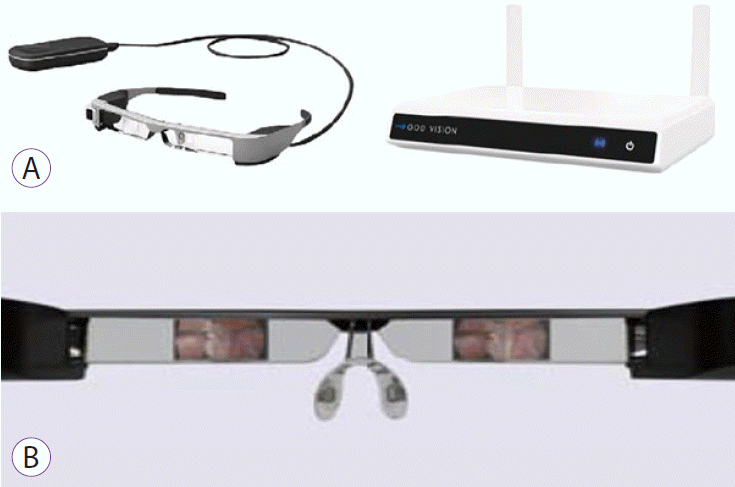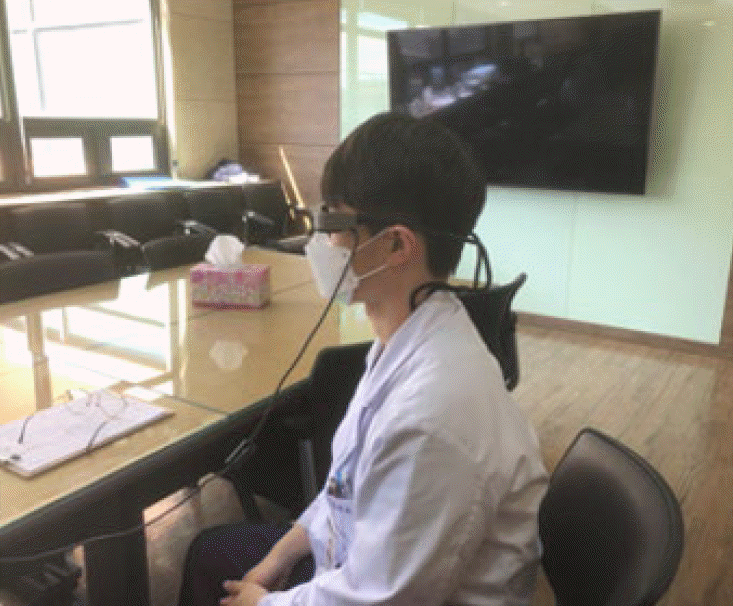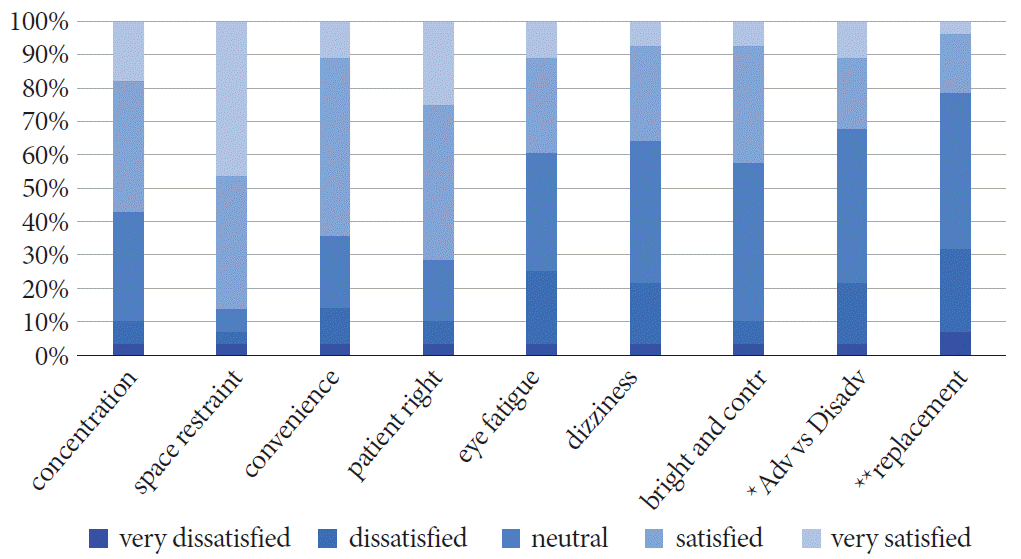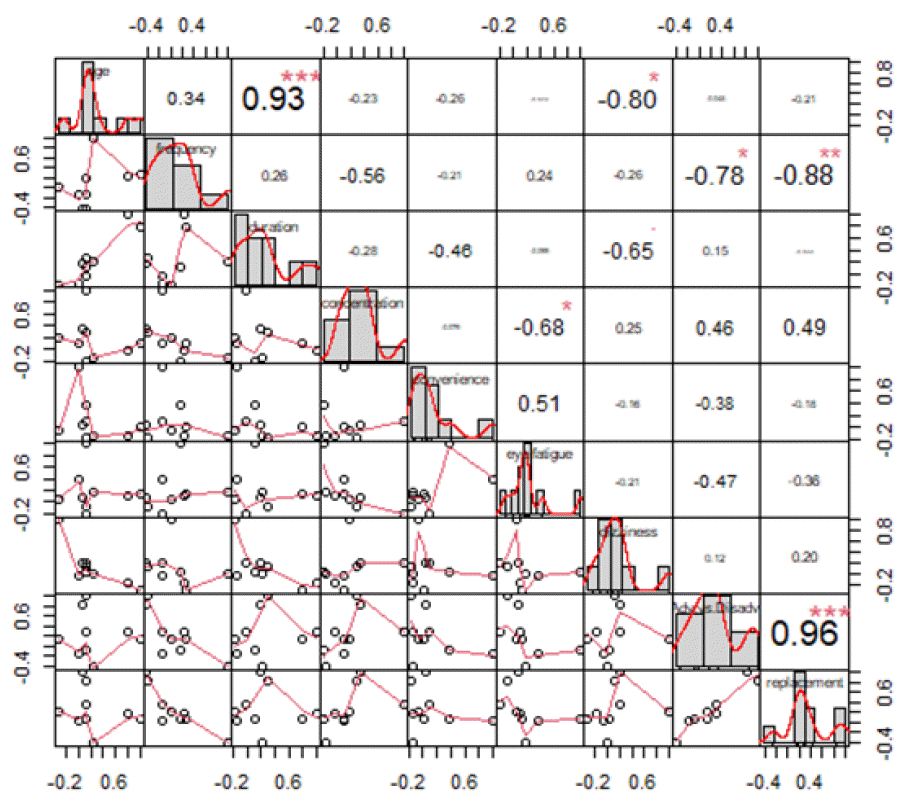Abstract
Background/Aims
Several attempts have been made to incorporate smart glasses in the medical field. We applied wearable display glasses to show the position of an observer during endoscopy and compared students’ responses between the conventional and new methods.
Methods
We surveyed 28 medical students regarding the use of wearable display devices. The students used wearable display glasses to observe an endoscopic procedure and answered the prepared questionnaire. Their collected responses were analyzed for statistical correlations between each variable.
Results
The survey of medical students revealed disadvantages including dizziness (dissatisfied and very dissatisfied: 21.5%) and eye fatigue (25% dissatisfied) and advantages including concentration (satisfied and very satisfied: 57.2%) and securing patient rights (71.4%). The students showed more positive than negative reviews regarding the new devices (32.1% vs. 21.5%).
Conclusions
We investigated the advantages and disadvantages of viewing the endoscope image with new wearable display glasses compared to the conventional method using the survey to record user experience. The results revealed relatively positive responses from the medical students in the survey. If the new device compensates for some shortcomings, its use in the endoscopy room will be feasible.
The first augmented reality-based smart glasses (Google GlassTM; Google, Mountain View, CA, USA) were introduced in 2012 and withdrawn from the market in 2015 because of safety issues and high cost. However, the development team has established a new company and developed new, custom augmented reality-based wearable glasses at the request of various companies for incorporation into industrial production sites in various forms.
Doctors have recently started to focus on wearable display devices, especially in the surgical field. With laparoscopic and robotic surgery becoming common, interest in the use of wearable display devices has increased [1-3]. Experimental trials have been performed for surgeons using various wearable devices [4,5]. With the introduction of intraoperative consultations via telementoring in the surgical field, Google Glass has been applied in various surgical procedures [6,7]. Efforts have been made to develop a new device in the surgical field to address surgeon fatigue due to maintaining a rigid posture while looking at the monitor. In the operating room, repeated actions performed in a fixed position for a long time can strain surgeons’ cervical muscles and cause chronic pain [8,9]. Thus, wearable display glasses were developed to allow surgeons to view the laparoscopic surgical screen without adopting a fixed posture.
The developed device can be easily installed on a variety of medical devices, including laparoscopes, arthroscopes, endoscopes, and ultrasound machines, and has the advantage of being connected with relatively simple equipment. In addition, the device can transmit data wirelessly in real time with relatively fewer space constraints and help the operator to focus on the procedure using a free posture. To allow the operator to perform procedures in a relaxed state without staring at a monitor, the monitor screen was implanted into a pair of wearable display glasses. Moreover, surgeons are increasingly interested in the potential for wearable display glasses to reduce fatigue as well as for its education and training applications [10].
A recent study in South Korea reported that an estimated 90% of endoscopy specialists complained of musculoskeletal pain [11]. Manipulating a scope while staring at the monitor in a fixed position is similar to the surgical procedure in the operating room. Thus, we applied wearable display glasses in an endoscopy room and assessed user satisfaction based on their experiences with the conventional method and new method based on wearable display glasses. Before the endoscopic operators wore the glasses during the procedure, we surveyed students regarding their experiences with the use of wearable display glasses. Many changes, especially regarding patients’ right to privacy, in the medical setting are required in the existing methods of endoscopic education. With the increasing protection of patients’ personal information and rights, medical students have decreased opportunities to participate in bedside education [12,13]. Moreover, with the recent emergence of coronavirus disease (COVID-19), all sectors of society are changing to non-face-to-face forms. Students previously studying at school are now instead watching lecture videos online at home. Under such circumstances, wearable display glasses may provide a good educational opportunity for medical school students, in whom the satisfaction level of watching videos of endoscopic procedure on wearable display glasses should be examined. If watching endoscopic procedures with wearable display glasses provides educational effects comparable or superior to those of observing endoscopic monitor screens in the endoscopy room and in distant space, then the use of the glasses can ensure not only patient rights but also provide educational opportunities. Before confirming the educational effects of the use of wearable display glasses, a survey based on medical students’ experiences was conducted as a preliminary evaluation. The survey was conducted by comparing the new method (watching the screen of wearable display glasses) to the conventional method (watching the endoscope monitor screen by the bedside) of observation.
This study used a commercially available device (GV-100; MediThinQ Co., Ltd., Seongnam, Korea). These wearable display glasses are not virtual reality or augmented-reality screens, but rather are devices that transmit an endoscope monitor’s screen to the lens of the glasses. The device is very light and causes no particular discomfort to the user while watching the endoscopic procedure. The device consists of smart glass, a controller, and a main unit module (Fig. 1A). The main unit and controller can send and receive imaging information wirelessly. Endoscopic images transmitted to the controller are projected in real time onto the lens of the glasses in front of the observer’s eyes. Based on actual experience, smooth image signal transmission is possible without interference up to a distance of approximately 15 m. The device is certified by the US Food and Drug Administration for use in medical equipment. The specifications of the wearable display devices are shown in Table 1.
This study was performed from February to March 2020. A survey was conducted regarding the decision to use wearable display glasses for student education. The survey asked 28 medical school students to compare what they watched on the monitor in the endoscopy room to what they watched on the wearable display glasses in a separate room (Fig. 2). All students, wearing wearable display glasses, watched two sets of gastroscopic and total colonoscopic procedures being performed in the endoscopy room. On average, the students observed the endoscopic procedures through the wearable devices for more than 30 minutes. A survey was used to evaluate the observer’s concentration during the procedures. The degree of concentration was divided into five classes: very satisfied, satisfied, neutral, dissatisfied, and very dissatisfied. In addition, space constraints; patient rights; eye fatigue due to wearable display device use; and differences in color, brightness, and contrast between the conventional monitor screen and the wearable display glasses were also assessed. Students who participated in the experiment were asked to grade each answer. This study was approved by the Institutional Review Board of Korea University (IRB number: K2020-0918-002).
Since the survey was conducted on students, they were asked to complete consent forms before the experiment. Thus, the students had listened to sufficient prior explanations of the research and agreed to participate in the study. Despite the lack of actual coercion, we later realized that the students might have been forced to participate in the experiment because of the hierarchy in the hospital at the time of obtaining consent due to a lack of effort in considering the participating students during the study design.
The primary outcome of the study was the results of the survey on medical students’ satisfaction and assessment of the convenience of the use of the wearable display glasses. Medical school students who had experience with the conventional method of watching endoscopic procedures were administered satisfaction surveys, which were analyzed using structured questionnaires with score scales regarding the advantages and disadvantages of wearable display devices.
Continuous variables are expressed as means and standard deviations, while categorical variables are expressed as frequencies and fractions. Multivariate correlation analysis of non-normally distributed variables was performed using Kendall’s τ correlation analysis to identify ordinal associations. All analyses were conducted using R statistics ver. 4.0.0 (R Foundation for Statistical Computing, Vienna, Austria).
An image displayed in the field of view is shown in Fig. 1B. According to the wearer’s subjective review, there was no significant difference from the conventional method of staring at the monitor with the naked eye; however, the disadvantages included mild dizziness with long-term use and differences in brightness and contrast. Thus, the negative assessments of the users regarding the use of wearable display glasses were some differences in color, contrast, brightness, and clarity compared to the conventional endoscopy monitor. However, these are technically solvable issues.
The baseline characteristics of the 28 medical school students (16 men [57.1%], 12 women [42.9%]; mean age, 26.14±2.09 years; total smart device use duration, 10.86±2.48 years) who participated in the survey are shown in Table 2. The survey participants were relatively young and had used smartphones from an early age because they were students. Twelve students (42.9%) reported using smartphones or smart devices for 2–4 hr daily, nine (32.1%) reported use exceeding 4 hr daily, six (21.4%) reported 1–2 hr, and only one (3.6%) reported 30 min to 1 hr. No student reported using smart devices <30 min a day. Thirteen (46.4%) students reported that they had no prior experience with using wearable devices such as virtual reality or alternative-reality devices, while the other 15 (53.6%) reported having used them previously.
We evaluated the questionnaire responses in terms of “very satisfied, satisfied, neutral, dissatisfied, and very dissatisfied” or “strongly agree, agree, neutral, disagree, and strongly disagree” (Table 3). Each questionnaire prompt is provided in parentheses. In terms of concentration (“Using a wearable display device helped to concentrate on observing the endoscopic procedure compared to the existing conventional monitor method.”), 17.9%, 39.3%, 32.1%, 7.1%, and 3.6% of respondents reported feeling very satisfied, satisfied, neutral, dissatisfied, and very dissatisfied, respectively. In terms of freedom from space constraints (“Using a wearable display device, there was no space limitation when observing an endoscopic procedure, compared to the conventional monitor method.”), the responses were 46.4%, 39.3%, 7.1%, 3.6%, and 3.6%, respectively. For patient’s convenience (“Using a wearable display device, I think that the patient may be convenient because the observer is not in the operation room when observing the endoscopic procedure, compared to the existing monitor method.”), the responses were 10.7%, 53.6%, 21.4%, 10.7%, and 3.6%, respectively. In terms of patient rights promotion (“I think using a wearable display device will help improve patient rights, such as the right to confidentiality, compared to the existing monitor method.”), the responses were 25%, 46.4%, 17.9%, 7.1%, and 3.6%, respectively. In terms of eye fatigue (“Using a wearable display device was more tiring in the eyes when observing an endoscopic procedure compared to the conventional monitor method.”), the responses were 10.7%, 28.6%, 35.7%, 21.4%, and 3.6%, respectively. Regarding dizziness (“Using a wearable display device caused more dizziness when observing an endoscopic procedure compared to the conventional monitor method.”), the responses were 7.1%, 28.6%, 42.9%, 17.9%, and 3.6%, respectively. For color awkwardness (“Using a wearable display device was more uncomfortable in terms of color, brightness, and contrast when observing an endoscopic procedure, compared to the conventional monitor method.”), the responses were 7.1%, 35.7%, 46.4%, 7.1%, and 3.6%, respectively. Regarding whether the advantages outweighed the disadvantages (“I think that using a wearable display device will have more advantages than disadvantages when observing an endoscopic procedure, compared to the conventional monitor method.”), the responses were 10.7%, 21.4%, 46.4%, 17.9%, and 3.6%, respectively. In terms of the prospects for replacement (“In the future, I think that using a wearable display device can replace the existing monitor method.”), 3.6%, 17.9%, 46.4%, 25%, and 7.1% of respondents reported feeling very satisfied, satisfied, neutral, dissatisfied, and very dissatisfied, respectively. The above results are summarized in a bar graph (Fig. 3). In the survey, 57.2% of the medical students reported being more focused while watching through wearable display glasses than while watching the monitor with the naked eye. Thus, the students were interested in observing the endoscopic images using the new method.
A multivariate correlation analysis was conducted based on the survey responders’ reported use of smart devices (Table 2) and the ratio of student degrees of satisfaction (Fig. 3). The analysis aimed to determine whether responder age, frequency of smartphone use, and smart device experience were correlated with the degree of satisfaction with the use of the wearable display glasses. We quantified the correlation coefficients of the nine questions and determined which items showed positive correlations (reference range, 0.7–1.0) (Fig. 4). Since students in their late 20s and early 30s would have had much longer periods of smartphone use compared to students in their early 20s, there was a highly positive correlation between age and smart device experience, with a correlation coefficient of 0.93. In addition, the correlation between students who answered that the advantages outweighed the disadvantages and those who answered positively regarding the possibility of replacement by the new device had a correlation coefficient of 0.96. Age and dizziness were among the items expected to have a negative correlation (correlation coefficient, -0.80). In addition, concentration and eye fatigue had a correlation coefficient of -0.68, showing a weakly negative correlation. Dizziness and the duration of smart device use showed a correlation coefficient of -0.65, which also indicated a mildly negative correlation. The greater the daily smartphone use duration, the more negative the assessment of the wearable display glasses (correlation coefficients of -0.78 and -0.88 for “advantages outweigh disadvantages” and “possibility of replacement”, respectively).
Many studies have attempted to incorporate various types of equipment into the medical field. For example, endoscopic submucosal dissection using a head-mounted display device has been described in Japan, in which the endoscopic operator performed the procedure in a comfortable position while using the display, thus demonstrating its feasibility for endoscopic submucosal dissection procedures [14]. Studies also continue to examine the use of wearable devices in various procedures, including endoscopic submucosal dissection.
To accurately compare the new device to the existing methods of observation, the students were divided into two groups. The experimental group used the new device while the other group maintained the existing method of observation. However, a comparison of the scores for a test of basic knowledge of endoscopy after the observation between these groups was not possible because the number of students who participated in the study was not sufficient to derive statistical meaning. Therefore, we instead applied a questionnaire survey.
This study was conducted in a single institution and included an insufficient number of participants. Hence, sufficient data are lacking; therefore, the statistical power may be low. This study was not designed to identify the statistical significance of a specific hypothesis; rather, it attempted to incorporate a new device, the wearable display glasses, into the endoscopy room. In a previous study as well as the present study, glasses users showed high levels of concentration during the procedure. According to other study for performing therapeutic endoscopic procedures with wearing a face-mounted display system, it showed mainly positive response of the operator for the new device [15]. However, it was difficult to apply the new device to the patient immediately for our study, because safety concerns remain.
We analyzed the survey results from medical students after their use of wearable display glasses. However, it is debatable whether such surveys are appropriate for the evaluation of the educational effect. The questionnaire items comprising the survey are likely to involve many subjective opinions. Therefore, the absolute percentage of satisfaction responses would not likely have much significance in medical research. In addition to listing the response rates of satisfaction, we assessed their meaning based on correlation analyses between the questionnaire items. The correlation coefficients were calculated using multivariate correlation analysis. Because the survey was conducted on students, the survey participants were relatively young, mostly in their 20s. The age difference was not significant. The correlation between age and duration of smart device use (correlation coefficient, 0.93) and that between the assessment of whether the advantages outweighed the disadvantages and the probability of replacement (correlation coefficient, 0.96) demonstrated positive associations. Our results also confirmed the non-significant correlation between the frequency of smartphone use and the assessment of wearable display glasses. One explanation for this result is that the number of subjects was insufficient. Moreover, this relationship may not be relevant. We assumed that students with a high frequency of smartphone use would quickly adapt to wearable display glasses and respond well because they are familiar with electronic products [16]. However, the survey results did not show a significant correlation. It may be biased to assume that someone familiar with a smartphone will believe that other smart devices will also be familiar. A larger number of participants is required to ensure a more accurate assessment and to demonstrate statistical significance in future studies.
The introduction of new methods often leads to resistance or rejection. Endoscopy education commonly occurs as in-person interactions between professors and students. However, the space in the endoscopy room is physically limited with the combination of endoscopy doctors, nurses, patients lying down, and two or three students observing. Moreover, at a time when distancing is becoming more common in the COVID-19 era, it may do more harm than good to insist on having many people gathered in a small space. In these circumstances, one might consider a new device rather than in-person training. Wearable display glasses could be an alternative to lowering the population density in the endoscopy room and allowing students to view the endoscopy screen.
If future studies show no difference or more advantages compared to conventional monitoring, additional research will be needed regarding the feasibility of the endoscopic operator using wearable display glasses to perform the procedure. Comparisons between endoscope manipulation while staring at the monitor (conventional method) and the wearable display glasses (new method) are not expected to show significant differences in procedural safety and efficacy. As mentioned previously, wearable display glasses are considered an effective device for reducing fatigue related to endoscopic procedures. A previous study in the United States reported the use of a video headset similar to the wearable display glasses to perform colonoscopies. The results showed that the image quality was poor but that the operator neck strain was reduced [17]. The present study demonstrated the possible use of a wearable display device for educational purposes, suggesting its potential increased use in the endoscopy room. However, trials are needed to identify the specific potential uses of this device in this setting.
Some users of wearable display glasses reported color changes, including brightness and contrast. Therefore, performing endoscopy while utilizing wearable display glasses cannot currently be attempted due to safety issues. However, we identified the benefits of allowing the observer to watch the endoscopic procedure regardless of space limitation and enhancing patients’ right to privacy. In addition, compared to the conventional method, the medical students using the wearable display glasses showed relatively positive responses in the survey. For this new device to be commonly used in the future, its reported shortcomings such as eye fatigue, dizziness, and awkwardness in color differences must be addressed.
REFERENCES
2. Muensterer OJ, Lacher M, Zoeller C, Bronstein M, Kübler J. Google Glass in pediatric surgery: an exploratory study. Int J Surg. 2014; 12:281–289.

3. Davis CR, Rosenfield LK. Looking at plastic surgery through Google Glass: part 1. systematic review of Google Glass evidence and the first plastic surgical procedures. Plast Reconstr Surg. 2015; 135:918–928.
4. Wong BJ-F, Lee JP, Dugan FM, MacArthur CJ. Head-mounted display for use in functional endoscopic sinus surgery. In : PHOTONICS WEST ‘; 1995 Feb 1-28; San Jose (CA), USA. Bellingham (WA): SPIE;1995. p. 337.

5. van Lindert EJ, Grotenhuis JA, Beems T. The use of a head-mounted display for visualization in neuroendoscopy. Comput Aided Surg. 2004; 9:251–256.

6. Sebajang H, Trudeau P, Dougall A, Hegge S, McKinley C, Anvari M. Telementoring: an important enabling tool for the community surgeon. Surg Innov. 2005; 12:327–331.

7. Hashimoto DA, Phitayakorn R, Fernandez-del Castillo C, Meireles O. A blinded assessment of video quality in wearable technology for telementoring in open surgery: the Google Glass experience. Surg Endosc. 2016; 30:372–378.

8. Lee GI, Lee MR, Green I, Allaf M, Marohn MR. Surgeons’ physical discomfort and symptoms during robotic surgery: a comprehensive ergonomic survey study. Surg Endosc. 2017; 31:1697–1706.

9. Schlussel AT, Maykel JA. Ergonomics and musculoskeletal health of the surgeon. Clin Colon Rectal Surg. 2019; 32:424–434.

10. Peden RG, Mercer R, Tatham AJ. The use of head-mounted display eyeglasses for teaching surgical skills: a prospective randomised study. Int J Surg. 2016; 34:169–173.

11. Kim N, Jang ES, Park SM, Lee J-C. Work-life conflict and its health effects on Korean gastroenterologists according to age and gender. Gastroenterology. 2019; 156(6 Suppl 1):S–961.
12. Malpas PJ, Bagg W, Yielder J, Merry AF. Medical students, sensitive examinations and patient consent: a qualitative review. N Z Med J. 2018; 131:29–37.
13. Wanderley MDS, Sobral DT, Lima BAO, et al. Attitudes and personal attributes regarding patient receptivity towards the participation of medical students in gynecological consultations: a cross-sectional study. Rev Bras Ginecol Obstet. 2019; 41:613–620.

14. Morisawa T, Kida H, Kusumi F, Okinaga S, Ohana M. Endoscopic submucosal dissection using head-mounted display. Gastroenterology. 2015; 149:290–291.e1.

15. Yoshida T, Inoue H, Iwai T. A new face-mounted display system: pilot trial of clinical application in therapeutic endoscopy. Endoscopy. 2000; 32:974–976.

Fig. 1.
(A) Components of the wearable display glasses, including smart glass, a controller, and the main unit module. (B) Wearer’s view.

Fig. 2.
A medical student views the endoscopic images on wearable display glasses and responds to a survey regarding satisfaction with the use of the new device.

Fig. 3.
Bar graph demonstrating the percentages of student satisfaction as assessed by questionnaires.
*Advantages outweigh the disadvantages.
**Prospects for replacement.

Table 1.
Specifications of the Wearable Display Glasses
| Specifications | Values | |
|---|---|---|
| Display performance | Display type | Si-OLED |
| Resolution | 1280 × 720 | |
| Viewing angle | 23’ | |
| Virtual screen size | 320 inches | |
| Color reproduction | 24-bit color | |
| Wireless standard | IEEE 802.11N 5 GHz | |
| Power | Battery | 2,950 mAh |
| Actuation timea) | 4.5 hr | |
| Size | Headset | 178 × 191 × 25 mm |
| Controller | 116 × 56 × 23 mm | |
| Weight | Headsetb) | 69 g |
| Controller | 129 g |
Table 2.
Demographics and Baseline Characteristics of the Medical Students Who Responded to the Survey
Table 3.
Categories and Subjects Included in the Questionnaire Regarding the Users’ Experiences with the Use of the Wearable Display Glasses




 PDF
PDF Citation
Citation Print
Print




 XML Download
XML Download